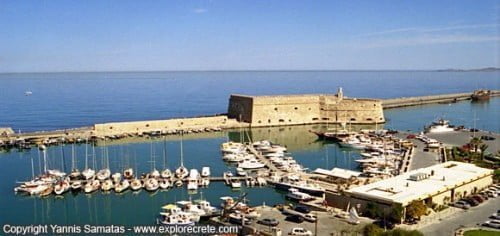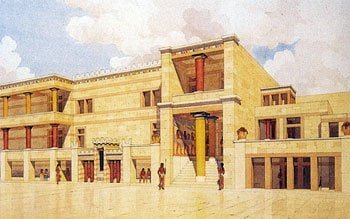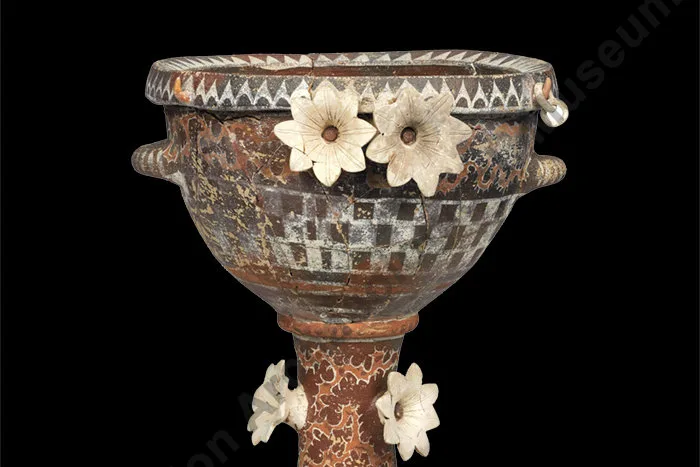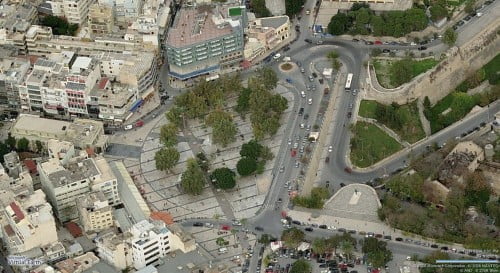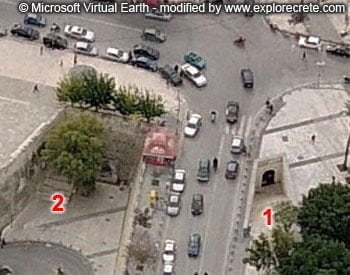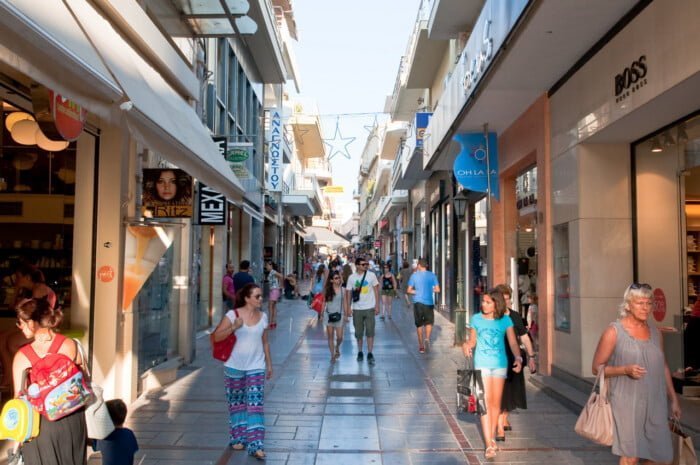Saint Minas in Heraklion, the patron saint of Heraklion
Saint Minas or Agios Minas in Greek
Saint Minas (Agios Minas in Greek) is the patron saint of Heraklion and his feast-day, on 11 November, is a public holiday. To go to the Cathedral of Saint Minas, walk along Vikela Street and then Agiou Mina Street, a five-to-ten-minute walk at most.
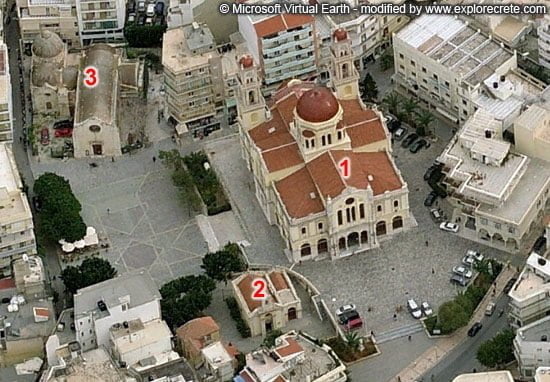
In front of the Cathedral of Saint Minas is a large paved square. To the right is the Archiepiscopate of Crete, while to the left is the original little church of Saint Minas. The original church of Saint Minas, little Saint Minas as the local call it (“mikros Agios Minas” in Greek), was built in 1735 and housed the Metropolis of Crete for the first time after the Turkish occupation.
Next to Saint Minas is the church of Agia Ekaterini (St Catherine of Sinai) and Saint Catherine Square.
Saint Minas, protector of Heraklion
Saint Minas or Menas was born in Egypt in the mid-3rd century AD to idolatrous parents, but became a Christian in adolescence. When he came of age, he decided to follow a career in the Roman army and served as a cavalry officer in Asia Minor.
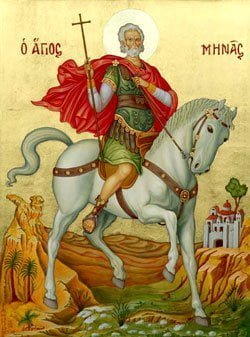
In 303 AD began the great persecution of the Christians under the Emperors Diocletian and Maximian, which lasted until 311 AD. Roman soldiers were ordered to arrest and torture Christians to make them renounce their faith.
St Minas, true to his faith, resigned from the Roman army and lived as a hermit in the mountains. When he was about 50 years of age, a divine vision revealed that the time had come for him to suffer martyrdom. He left the safety of the mountains and went down to the city, where he declared his faith before the idolaters.
He was arrested, imprisoned and horribly tortured. He was whipped, flayed and dragged naked along a road of sharp stones. Despite his horrific martyrdom, the saint refused to renounce his faith and was eventually beheaded.
Saint Minas was declared the patron saint of Heraklion during the Turkish period. The difference of religion between Cretans and Turks led to Muslim acts of violence against the Christians. Tradition has it that on Easter Sunday 1826, when the Christians were gathered in church attending the Resurrection service, a Muslim mob plotted to slaughter them. An aged officer on horseback, resembling their fiercest warrior, Ayan Agha, intervened, calming and dispersing the mob. The Christians attributed the appearance of the rider to a miracle of St Minas, believing that it was he, rather than Ayan Agha, who had appeared to the Turks. Even if the Turks were right, however, and the rider was not St Minas, it would have been a miracle for the Turkish persecutor of the Christians to act as their protector at the last moment.
Ever since, St Minas has been depicted as a Roman general on horseback and honoured as the patron saint of Heraklion. In his book “Agios Minas” (1939), Georgios Syllamianakis says that Minas was considered the protector of the city by not only the Christians but also the Turks, who regarded him with fear and respect.
Nikos Kazantzakis also wrote about the relationship of Heraklion to its patron saint:
“…The entire city was a garrison, each inhabitant himself a garrison eternally besieged, and as his captain he had a saint, Saint Minas, the defender of Megalo Kastro. A saint who did not remain only on his icon, who descended every night and went out on patrol. He closed whatever doors the Christians had forgetfully left open, he whistled to night owls to return to their homes, he stood outside the doorway and listened absorbedly, with satisfaction, whenever he heard singing…
…And whenever the Turks sharpened their knives and prepared to fall upon the Christians, Saint Minas sprang from his icon once more in order to protect the citizens of Megalo Kastro…
…For the Kastrians, Saint Minas was not simply holy, he was their captain. They called him Captain Minas and secretly brought him their arms to be blessed…”
(Report to Greco, trans. Peter Bien)
Miracles of the saint are also reported in more recent times; he is supposed to have protected his church during the heavy bombing of Heraklion on 23 May 1941. The large bomb which fell on the cathedral but failed to explode is on view outside Saint Minas today.
Saint Minas, the Cathedral
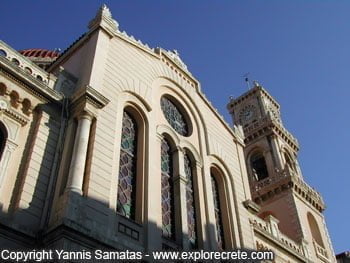
The foundations of the imposing cathedral of Saint Minas, one of the largest in Greece, were laid on 25 March 1862 as a token of gratitude by the citizens for the saint’s protection of the city. The site is said to have been indicated by a monk to whom St Minas appeared in a vision.
The cathedral was built by Athanassios Moussis, the architect of Agios Titos and the barracks in Eleftherias Square, which now houses the Prefecture and the Law Courts.
Building work on the cathedral was interrupted during the 1866 Rising, continuing in 1883. The effort to build the church in such difficult times was supported enthusiastically by all the people of Heraklion. The contemporary newspaper “Heraklion” reported that a sailing ship arrived in harbour loaded with building materials for the cathedral. However, the committee in charge of the project did not have the money to pay workers to carry the cargo from the ship to the building site. On learning this, the schoolchildren of Heraklion enthusiastically offered to unload the ship, forming a human chain from the harbour to Saint Minas and singing along to the hard work.
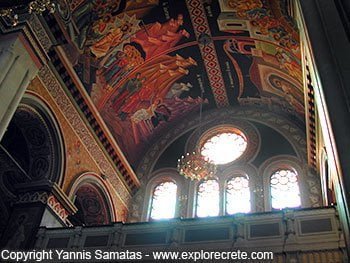
The cathedral was inaugurated with great pomp in 1895, under Metropolitan Bishop Timotheos Kastrinoyiannis. Although Crete was still under Turkish rule, the celebrations for the new cathedral of Saint Minas lasted three days, and the whole city was unrecognisable with its decorations and bright lights.
“Houses, streets and markets are now all pretty
Now that Ai-Minas is completed in the city.
Late on Saturday and Sunday, night was turned to day,
From all the lights that people lit and shone in the air so gay.
Lanterns, lamps, and candles, coloured tapers bright,
All the city shone as if it were full daylight.”
Why the name Minas is rare in Heraklion
The name Minas is rare in Heraklion, which sounds strange for a city whose patron saint he is. The reason for this is given in an old story that few now remember.
During the time of Turkish rule, illegitimate children were often left on the steps of the church of Saint Minas. The church took care of the children and named the boys Minas, after the saint at whose church they had been left. So, for many years in Heraklion the name Minas showed that the person bearing it was illegitimate, and people avoided giving their children that name.
© explorecrete.com All Rights Reserved. Reproduction or copying without permission is prohibited.

